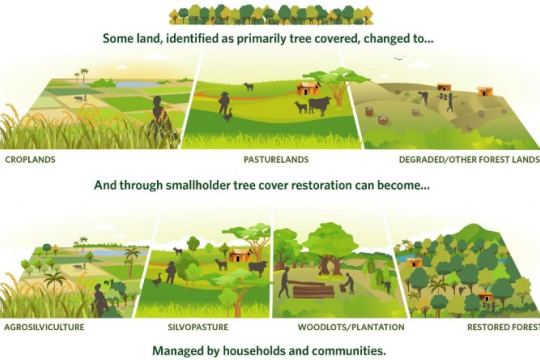Highlights
•Estimates tree cover restoration potential in croplands, pasturelands, and degraded forestlands.
•Identifies potentially impacted populations in tropical countries by land use type.
•Calculates smallholder farmland shares in countries with restoration potential.
•Assesses policy, institutional and market conditions enabling smallholder restoration.
•Uses expert knowledge to identify-four principles to advance smallholder restoration.
Restoring tree cover in tropical countries has the potential to benefit millions of smallholders through improvements
in income and environmental services. However, despite their dominant landholding shares in many
countries, smallholders’ role in restoration has not been addressed in prior global or pan-tropical restoration
studies. We fill this lacuna by using global spatial data on trees and people, national indicators of enabling
conditions, and micro-level expert information. We find that by 2050, low-cost restoration is feasible within 280,
200, and 60 million hectares of tropical croplands, pasturelands, and degraded forestlands, respectively. Such
restoration could affect 210 million people in croplands, 59 million people in pasturelands and 22 million people
in degraded forestlands. This predominance of low-cost restoration opportunity in populated agricultural lands
has not been revealed by prior analyses of tree cover restoration potential. In countries with low-cost tropical
restoration potential, smallholdings comprise a significant proportion of agricultural lands in Asia (~76 %) and
Africa (~60 %) but not the Americas (~3%). Thus, while the Americas account for approximately half of 21st
century tropical deforestation, smallholder-based reforestation may play a larger role in efforts to reverse recent
forest loss in Asia and Africa than in the Americas. Furthermore, our analyses show that countries with low-cost
restoration potential largely lack policy commitments or smallholder supportive institutional and market conditions.
Discussions among practitioners and researchers suggest that four principles – partnering with farmers



